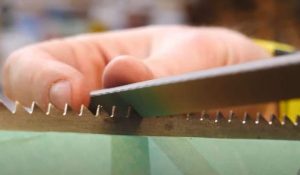Hand saw is the basic tool in woodworking for cutting wood pieces with your hands. Before the power tools era, hand saws were the main carpentry and woodcraft tool that got the jobs done.
However, even in the electric-powered saw era, handsaws are still useful and even allow you to make cuts while the power tools can’t. You might have wondered what is a hand saw used for. when electric hand saws for cutting woods are widely available in diverse types and options.
Different Types of Hand Saws

Hand saws come in many variants while some of them refer to specific cutting jobs depending on the materials you want to cut. You would need different saws for cutting plywood, wood posts, wood logs, and tree branches.
For woodworking, the cutting tasks commonly include cross-cutting, rip cutting, and curve cutting that also refer to the use of different hand saws.
- These are some common types of hand saws available in the market:
- General-purpose hand saw: Rip cutting wood. Also known as a wood saw or rip saw
- Tenon saw: Cutting tenon for wood joinery. Also known as backsaw
- Hardpoint Saw: Cutting Wood frame, cross-cutting. Also known as a pull saw or toolbox saw
- Plasterboard saw: Cutting drywall or plasterboard products. It’s also known as the drywall saw
- Hacksaw: For cutting metals and other non-wooden materials
- Pruning Saw: For cutting tree branches and small-sized logs. Also renowned as the garden saw
- Bow saw: Bigger pruning saw for cross-cutting denser wood. Also known as a frame saw
- Folding Hand saw: It is mainly a portable hand saw. You can take it in your pocket
Hand Saw Details (Specific Parts)
Material
Hand saws are typically constructed by two main components: the blade and handle. The blade can be made from tempered metals like steel or carbon steel.
Wooden handles have been used for hand saws for a long time today’s products also come with molded plastic handled and may be coated with rubber to support better grip
Blade
Saws always come with toothed blades or, in other words, any cutter with toothed blades can be called a saw. Different blades are now used to cut different materials like wood, plastics, drywall, boards, and metals.
Some hand saws like hacksaw or frame saw allow you to use different blades interchangeably.
Teeth
Saw blades have different teeth per inch(TPI) in their technical specifications. Technically, saws with lower TPI or bigger/coarser teeth are used for rip cuts(along the wood grain) while saw blades with higher TPI are used for crosscuts (across the wood grain).
General-purpose hand saws usually have 7-10 TPI for multiple cutting styles.
Cutting stroke
Hand saws are designed for push and/or pull cutting strokes to cut the materials. Rip cut saws are usually cut with push stroke for cutting along the wood grain. Crosscut saw allows you to apply push and pull stroke for cutting across the wood grain.
When to Use a Handsaw?
There are times when you can use a handsaw instead of an electric-powered saw. Hand saws allow you to cut larger timber where circular saw has not enough cutting depth.
You may prefer hand saws to cut materials where power saws are overkilling for tasks like cutting branches, undercutting, trimming, etc. Last, you may obviously consider using a handsaw when the power source is unavailable to operate the power tools.
What Is The Best Hand Saw for Cutting Trees?

Some types of hand saws can be used to cut trees including bow saw, pruning saw, razor tooth saw, and even general-purpose saw. If you want to cut the tree, you need a sharp, coarser saw blade to cut through the log smoothly and don’t go higher than 8 TPI.
Consider the size of the log and choose a saw with proper blade length to ensure it can accommodate the diameter of the logs of the tree you want to cut. Finer blade teeth allow a more precise cut but you may take more time and energy to cut the tree.
You may also have the durability, blade replacement, and safety features of the hand saw.
What Hand Saw for Cutting Metal?

A hacksaw is a straightforward option for cutting metal sheets, pipes, or shafts with your hand. The framed construction and adjustable blade tension allow perfect handling when cutting metal pieces.
The construction also allows you to replace blades with different TPI for the best suitable cutting just like hand saws for wood. Generally speaking, a hacksaw blade with less TPI is suitable for hard metal cutting like steel or iron while hacksaw blades with more and finer TPI are for cutting soft or not-hardened metals like aluminum.
Hacksaws are also used for cutting plastics, PVC, and even woods with a suitable hacksaw blade.
How do you sharpen a hand saw?
Sharpening the hand saw blade on a regular basis allows you to keep it at best performance for cutting wood smoothly even though it may be a little bit tricky at first. What you need to prepare including a triangular file and a nice spot in your workshop with good lighting. These are some steps to sharpen a handsaw:
- Apply the file strokes throughout the tooth in one direction like a knife sharpening step. Ensure to count the same strokes for each tooth for the first passes.
- Your next objective is to ensure the same height for all teeth along the blade. Apply more down strokes to even the height of the teeth.
- If your hand saws have notched teeth, you need to file them as well until they get sharp. Ensure the even depth of the notched teeth that are shorter than the main teeth of your hand saw. It’s a form of calibration that allows a more accurate cut as your strokes are distributed evenly through the teeth.
- After long usage, your saw blade teeth may get crocked. It’s a little bit tricky to bend them back to their original position but you may use a wooden hammer to apply some knocks when adjusting.
- Do the final check and adjustment, then try your sharpened handsaw.
How do you lubricate a hand saw?
Lubrication is an essential step for hand saw maintenance, especially after the usage or as you want to store it. You can use paste wax, gun oil, specialty lubricants to grease the hand saw blade.
If you use paste wax, you can apply it through the saw blade with a cloth and wait for several minutes before wiping off the wax. For lubrication with gun oil or specialty liquid-like WD-40, you can simply wipe the same blade, cloth, or other applicators.
The lubrication maintenance prevents corrosion on your saw blade and extends its life span.
What Are Different Lengths of Hand Saws?
When it comes to hand saws, there are various products with different lengths that actually refer to their particular functions. The shorter hand saws available in the market are 6” in length and the regular saws go from 12” up to 24” or even longer.
The length of the hand saw is strictly related to its function for cutting shorter or longer strokes and the user considers a shorter or more full range of arm movements. While longer saws allow you to cut the piece more quickly it requires more arms control and movements.
Generally speaking, you need the proper length of hand saws for the particular applications, types & size of materials, and your preference. You Must refer back to what is a hand saw used for in your projects.
Woodworkers typically have several hand saws with different lengths to cater to different cutting tasks.
What is the difference between a hacksaw and a hand saw?

A hacksaw and a handsaw are designed for different cutting purposes. A hack saw comes with a metal-based bow-like frame while the hand saw is constructed by a blade and handle only. These are some differences:
Hacksaw:
- Meta-Framed construction
- Finer, thinner saw blade
- Typically used for cutting non-wooden materials like metals, plastic, PVC, etc
- Denser Teeth, up to 32 TPI
- The blade is attached to the frame
- Easily replaceable blade
- Adjustable table with built-in gauge
Handsaw:
- Widely used for woodcutting including wood logs, post, boards, or tree branches
- No-frame construction, only blade, and handle
- Thicker, coarser, but less dense blade
- The blade is attached to the handle
- Non-replaceable saw blade (it’s more practical to buy a new one)
- Tension depends on the blade materials, can’t be adjusted
What Makes A Good handsaw
There are tons of handsaw products but not all of them are legit for your requirements and preferences. We can’t expect a cheap saw to support your heavy-duty works but even some premium saws aren’t suitable for the job either.
Blade Materials: Hardpoint steel is widely used to produce good quality hand saws in the market as they’re generally more reliable and durable. However, handsaws made from carbon steel are quite popular and even though not as good as hardpoint steel, they are workable handsaws for the jobs.
Handle: The design and materials of the handle is very important for the control and the comfort use of the handsaw. Wooden handles have been widely used in more premium hand saws but today, many hand saws also come with abs plastic handles with rubber-coated grips which are also awesome.
Construction: The blade and handle should make a rigid construction that makes the saw reliable for its particular cutting functions. Poor constructed hand saws may be torn apart or simply deliver hassle cutting performance when used.
Blade Teeth: Good hand saws are the ones that can deliver the results of what is a hand saw used for and it’s strictly determined by blade teeth. If you want to rip a wood piece along the grain, you can general-purpose handsaw. For crosscuts and finer results, you may consider tenon saws or Japanese saws that are more reliable for cutting across the wood grain.
Source:
- https://en.wikipedia.org/wiki/Hand_saw

Hi their! I am working with daily instruments since 2018. I complete my M.SC in Mechanical Engineering. I accomplished with commencement in 2009 from the College of Colorado Denver. Now I am working for a widely known tools firm. Sometimes i write informative article on my blog weeklytools.com & dailytools.com
